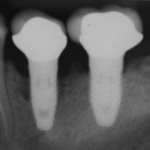
Peri-implantitis is a common problem following dental implant placement with a recent review (Dental Elf – 24th Oct 2022) estimating a patient level prevalence of 20% (95%CI; 16.6 to 23.7%). There is no consensus on treatment approaches for peri-implant disease with both surgical (Dental Elf – 17th May 2023) and non-surgical approaches being employed (Dental Elf – 15th Mar 2023).
The aim of this review was to compare the effectiveness of patient-performed or administered adjunctive measures to non-surgical peri-implantitis therapy.
Methods
A protocol was registered in the PROSPERO database. Searches were conducted in the Cochrane Library, PubMed and Scopus databases. English language randomised clinical trials (RCTs) or controlled clinical trials (CCTs) with a minimum of 10 patients and at least 6 months follow up were considered. The primary outcome was probing pocket depth reduction (PPD) and/or bleeding on probing (BOP) reduction. Secondary outcomes included implant loss, disease resolution, recurrence of peri-implantitis, need of re-treatment, changes in marginal bone levels, patient-reported outcomes and adverse effects. Two reviewers independently screened and selected studies with 3 reviewers independently extracting data. A single reviewer assessed study quality using the Cochrane risk of bias tool (RoB2). Owing to the large heterogeneity in included studies, no meta-analyses were performed.
Results
- 9 RCTS reported in 10 papers involving a total of 615 patients (797 implants) were included.
- 0ne RCT was considered to be at low risk of bias with 8 having some concerns.
- 4 studies evaluated local antimicrobials (minocycline microspheres, chlorhexidine chips or a metronidazole + amoxicillin gel), 3 systemic antimicrobials 9 either amoxicillin + metronidazole or metronidazole alone) and two studies probiotics (Lactobacillus reuteri strains).
- 3 studies reported PPD reduction at patient level and 2 studies a BOP reduction with systemic antimicrobials.
- Local antimicrobial led to modest improvements in PPD reduction.
Conclusions
The authors concluded: –
Different adjunctive measures in the non-surgical treatment of peri-implantitis have different impact in terms of PD and BoP reductions. Improved PD reductions result after the use of systemic antimicrobials, and to a lesser extent, after the use of local antimicrobials.
Comments
Working from a preregistered protocol the reviewers searched three major databases although restricting their inclusions to English language papers may have excluded some relevant studies. In line with previous reviews in this area (Dental Elf – 17th May 2023, Dental Elf – 15th Mar 2023) only a small number of studies were identified. These studies involved a wide range of interventions and generally only involved a small number of participants and only one studies was assessed as being at low risk of bias. The included studies also used various definitions of peri-implantitis which adds to the level of heterogeneity across the studies. While recent reviews have shown that some treatments for peri-implant disease (surgical and non-surgical) have a beneficial effect both the quality and quantity of available evidence is limited. High quality well conducted and reported studies of appropriate size and duration are needed on both the prevention and treatment of peri-implant disease.
Links
Primary Paper
Liñares A, Sanz-Sánchez I, Dopico J, Molina A, Blanco J, Montero E. Efficacy of adjunctive measures in the non-surgical treatment of peri-implantitis: A systematic review. J Clin Periodontol. 2023 May 4. doi: 10.1111/jcpe.13821. Epub ahead of print. PMID: 37143407.
Other references
Dental Elf – 24th Oct 2022
Dental Elf – 17th May 2023
Dental Elf – 15th Mar2023
Picture credits
By Coronation Dental Specialty Group[1] – Own work, CC BY-SA 3.0.
